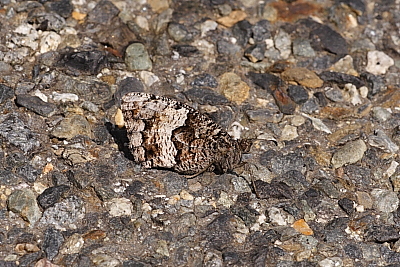









Rock Grayling (Hipparchia alcyone)
2024 photographs highlighted in yellow. Click on any photograph to go to an enlarged picture, or simply scroll down the page.
|
Alcyone and its very close relative the Woodland Grayling (H. fagi) are encountered reasonably frequently, perhaps more so fagi, but they are hard to distinguish from each other. Alcyone is generally smaller although this doesn’t help much unless you have two to compare or can measure an outstretched specimen, but having seen a good number of each, it is not impossible to tell them apart in the field according to size, although the size ranges of each can overlap.
I also have the general feeling that alcyone appears "cleaner" than fagi which tends to have an unh discal band that is irrorated with grey scaling; this may be completely misleading, though, and I will see if it holds true over a long period of time. Lafranchis cites this difference between the females of the two species, which is encouraging, but makes no mention of whether it is true (even to a lesser extent) for males.
Most of the more definitive features seem to relate to the upperside, which is of limited value for two species that habitually rest with closed wings. Lafranchis' ID book only makes reference to the uppersides or an inspection of the Julien organs (genitalia) which I am not prepared to do, and I am not convinced that such capture and inspection should be undertaken by people who either do not really need to and/or by people not fully qualified to do it without causing damage or distress.
The underside differentiating features seem to be a little hazy, the chief of which seems to centre around the discal line, in which fagi has a "little bite" out of the centre. |
It also appears to me that the unf ocellus has a clearer area of yellow around it in alcyone, whereas in fagi the darker area touches the top of the ocellus; also, if enough of the unf is visible, the darker line is slightly angled at vein 4 in fagi, and this is also true but more exaggerated and pointed in alcyone. The solid black unh line in the basal region seems to extend to the base of the wing in fagi but not quite in alcyone; again, this may have no real foundation. The only feature that seems reliable is the "clear" ocellus.
The undersides of both sexes are very similar, so it has not been possible even to suggest sexes. These identifications are really no more than best guesses. Life would be so much easier if Rock Graylings always sat on rocks and Woodland Graylings stuck to trees.
These are a selection of undersides showing the variation in the shape of the discal line and hence the difficulty in making an educated identification guess. Many of the identification rationales are based on the size of the butterfly when seen at the time.
The taxonomy of this group is not entirely clear. Recent works reference another species in the alcyone/fagi group, H. genava which has the English name of Lesser Woodland Grayling but the French name translates as the Swiss Grayling. The relationship and exact distributions of alcyone and genava are not completely clear, but Lafranchis shows it as Switzerland and parts of eastern France, whereas he shows alcyone as having a few isolated colonies in the Var and further west, but its main domain in the Pyrénées. |
| ref | sex |
observations |
alt. m |
| 22791 | M |
a male, based its taking of salts. there is a very small indentation in the middle of the discal line, but within the limits for alcyone I believe. |
1120 |
| 18201 | M |
from the same location as 22791, and with the absence of the "little bite". The basal line reaches the margin, so maybe this feature is not useful, but the clean area around the ocellus and the non-bite seems to point to alcyone. |
1120 |
| 27390 | M | the clear area around the unf ocellus plus the fact that it appeared "small" at the time, indicate alcyone. | 1490 |
| 39093 | M | quite a deep charcoal grey, almost black, colouring, contrasting strongly with the pure white post-discal band. | 1600 |
| 47447 | M | a male, a slightly browner ground colour than most. | 1000 |
| 8958 | ? |
for much the same reasons as 16837, although the basal black line reaches the base of the wing. |
1120 |
| 16837 | ? |
the clean feel, the absence of a bite in the discal line, the clean area around the unf ocellus, and the incomplete unh black basal line, all suggests alcyone. |
900 |
| 17902 | ? |
for much the same reasons as 16837. |
1120 |
| 43753 | ? | enough of the upf ocellus can be seen to ratify that this is indeed alcyone. | 990 |
| 3244 | ? | a reasonably straight discal line, with a clear white largely unmarked band, and the unf line only slightly angled at v4: all of these factors suggest alcyone. I had originally labelled this as fagi, but on reflection, there are more reasons to think it is alcyone. | 1000 |
27390_male_Hautes-Alpes_16Jul11
39093_male_Hautes-Pyrénées_24Jul15
47447_male_Alpes-Maritimes_18Jul20
8958_sex?_Hautes-Pyrénées_8Aug07
16837_sex?_Alpes-Maritimes_27Jun09
3244_sex?_Alpes-Maritimes_27Jul06